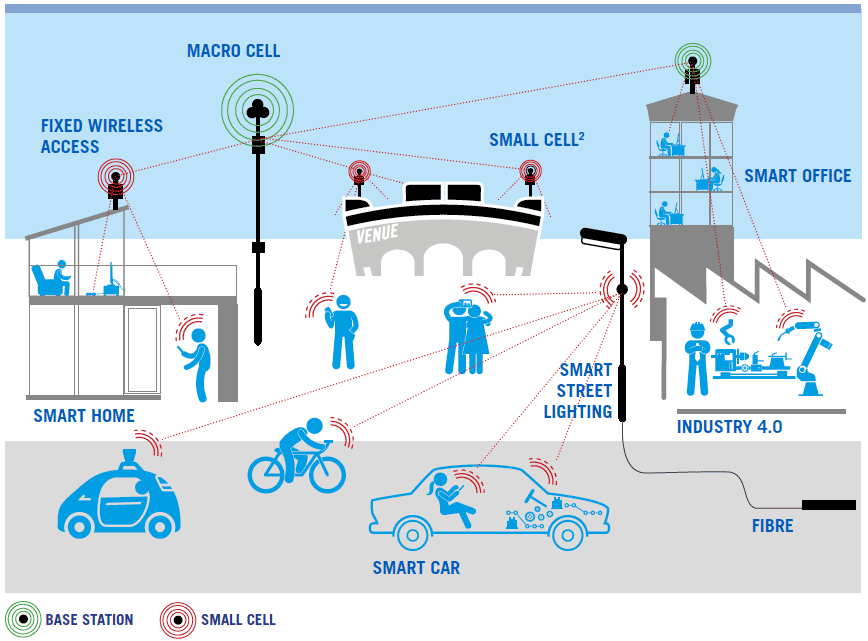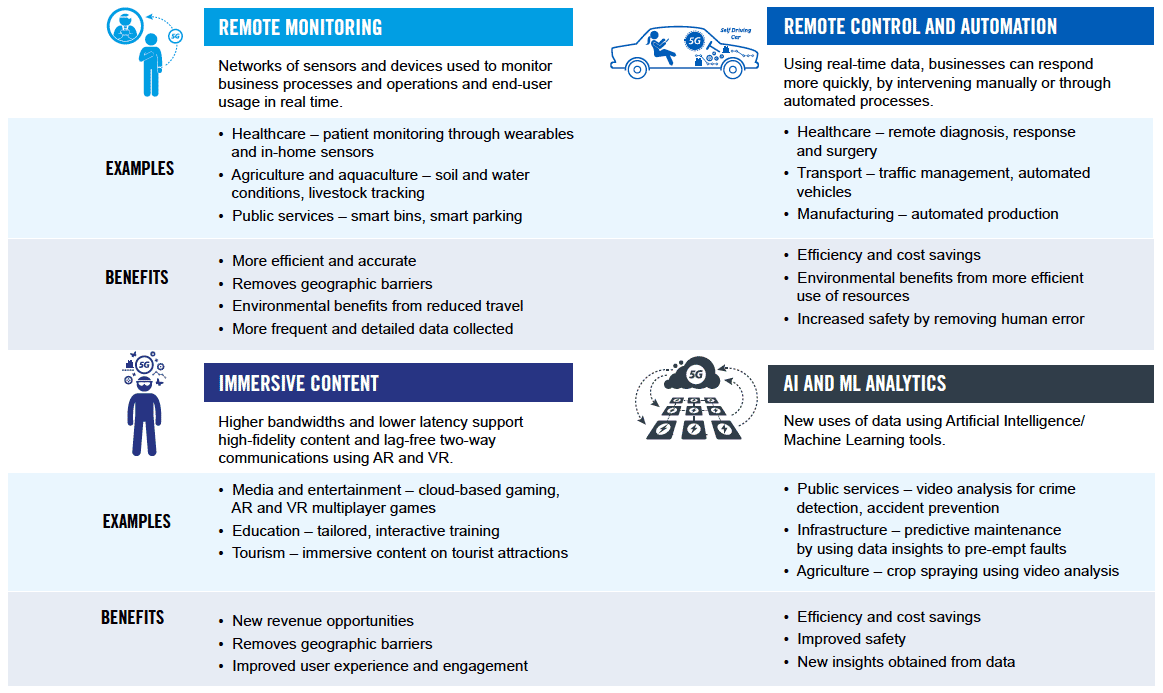5G: strategy for Scotland
A strategy outlining our vision for 5G and our commitment to embracing the opportunities it will give to build towards our aspiration to establish Scotland as a forward looking digital nation.
5G: The Basics
5G is a step up in the quality, capacity and flexibility of mobile wireless communications. 5G has the potential to offer greater reliability, much faster download and upload speeds, greater capacity to ease congestion and accommodate more connected devices or sensors. It also brings lower latency allowing near instant response with no time lag. All of this can enhance people's experience of technology and enable new ways of doing things.
But 5G is much more than just an enhanced version of the present 4G mobile broadband services. 5G will be central to the seamless delivery of high quality and reliable wireless connectivity in any urban or rural environment, in transit and on any mode of transport, including trains and planes.
Furthermore, 5G will have the ability to integrate with other wireless technologies, such as 4G, Wi-Fi and Internet of Things[1] (IoT) technologies.[2]
Figure 1 (not to scale)
Infographic:

Infographic text:
Diagram of an anticipated typical 5G urban network deployment
Different technologies will be able to seamlessly interact on the move so that a user's device can decide which technology offers the best user experience. As shown in figure 1, this will depend on the user's device accessing the different modes of wireless connectivity throughout any journey.
5G: An Enabling Technology
The technical capability of 5G will satisfy the needs of a wide range of innovative so-called 'use cases' - in terms of extended bandwidth, reliable ultra-low latency, and/or a high density of connected devices, in combination with technologies such as cloud computing, IoT, Augmented Reality (AR) and Virtual Reality (VR) as well as advances in robotics and data analytics.
The Scottish Government has an aspiration for Scotland to be among the global leaders in IoT and the adoption of sensor technologies, which will help drive economic growth, transform public services and give citizens better and healthier lives. In collaboration with public and private sector partners, we are investing £2.8 million in infrastructure to create wider access to IoT and are taking forward activity to ensure our businesses, public sector and citizens understand why this technology is crucial to the way we work and live in the future.
Wireless networks will transmit data between devices, to the cloud, and back to end-user devices. Cloud services are becoming more ubiquitous, allowing increasingly integrated data analytics and AI capabilities. 5G will enable data to be moved rapidly and enable more devices to be connected simultaneously. Together these technologies allow new use cases to be built on top of wireless connectivity and real-time data, from video analysis, to automated vehicles, robotic factories and drones. For the individual, 5G opens up immersive audio-visual applications which bring to life a raft of new professional and leisure activities.
The Scottish Government will play an active role in developing the ethical frameworks and infrastructure to enable the technology to be used for the benefit of Scotland's citizens. Currently, the Edinburgh and South East Scotland City Region Deal contains significant Scottish and UK Government investment into data-driven innovation. 5G rollout in the region will benefit this activity.
Creative industries, including software, computer games, design, and animation, is one of the fastest growing sectors in Scotland. Here innovative businesses rely on seamless interaction between different technologies and instant communication across the globe. The value lies in an ability to connect and create new products and services using immersive technologies and data analytics.
Potential 5G use cases typically involve one or more of the following elements as shown in figure 2.
Figure 2
Infographic:

Infographic text:
Remote Monitoring
Networks of sensors and devices used to monitor business processes and operations and end-user usage in real time.
Examples
Healthcare - patient monitoring through wearables and in-home sensors
Agriculture and aquaculture - soil and water conditions, livestock tracking
Public services - smart bins, smart parking
Benefits
More efficient and accurate
Removes geographic barriers
Environmental benefits from reduced travel
More frequent and detailed data collected
Immersive Content
Higher bandwidths and lower latency support high-fidelity content and lag-free two-way communications using AR and VR.
Examples
Media and entertainment - cloud-based gaming, AR and VR multiplayer games
Education - tailored, interactive training
Tourism - immersive content on tourist attractions
Benefits
New revenue opportunities
Removes geographic barriers
Improved user experience and engagement
Remote Control and Automation
Using real-time data, businesses can respond more quickly, by intervening manually or through automated processes.
Examples
Healthcare - remote diagnosis, response and surgery
Transport - traffic management, automated vehicles
Manufacturing - automated production
Benefits
Efficiency and cost savings
Environmental benefits from more efficient use of resources
Increased safety by removing human error
AI and ML Analytics
New uses of data using Artificial Intelligence/Machine Learning tools.
Examples
Public services - video analysis for crime detection, accident prevention
Infrastructure - predictive maintenance by using data insights to pre-empt faults
Agriculture - crop spraying using video analysis
Benefits
Efficiency and cost savings
Improved safety
New insights obtained from data
New use cases enabled by 5G will have profound implications for Scotland. With a low population density and approximately 330,000 residents living in remote rural areas, the potential benefits from remote service delivery will be particularly significant in Scotland. The benefits will be in terms of social care, healthcare, primary and higher education and employment training.
The capabilities of 5G could be applied in sectors where Scotland already has a leading edge, such as healthcare, transport, education, public service delivery, energy, agriculture and aquaculture. These potential use cases could transform the way services are delivered by driving national productivity, delivering efficiencies and improving the consistency and reliability of the user experience.
In the Deloitte study Scotland's Digital Potential with Enhanced 4G and 5G Capability[3], potential use cases have been analysed in the context of Scotland's existing competitiveness and innovation. The key industry groups combined account for more than a quarter of total employment in Scotland.
- Energy, Quarrying and Utilities - A key component of this industry group is the oil and gas extraction industry, though the electricity sector also accounts for a relatively high share of employment.
- Agriculture, Forestry and Fishing - Fishing and aquaculture are areas of strength for Scotland with farmed salmon the UK's largest food export, though agricultural activities also rank highly.
- Public Administration - Across the spectrum of activities related to public services, the public sector is a particularly prominent employer in Scotland relative to the UK as a whole.
- Health and Well-Being - This includes hospitals, medical research facilities and community health clinics which employ around 170,000 people in Scotland, as well as social work and care for the elderly.
Figure 3 summarises the opportunities in areas aligned with the key industry groups above. In addition, other industries where 5G could generate a transformative impact in Scotland are transport; media, entertainment and learning; tourism, advanced manufacturing and logistics.
Contact
There is a problem
Thanks for your feedback